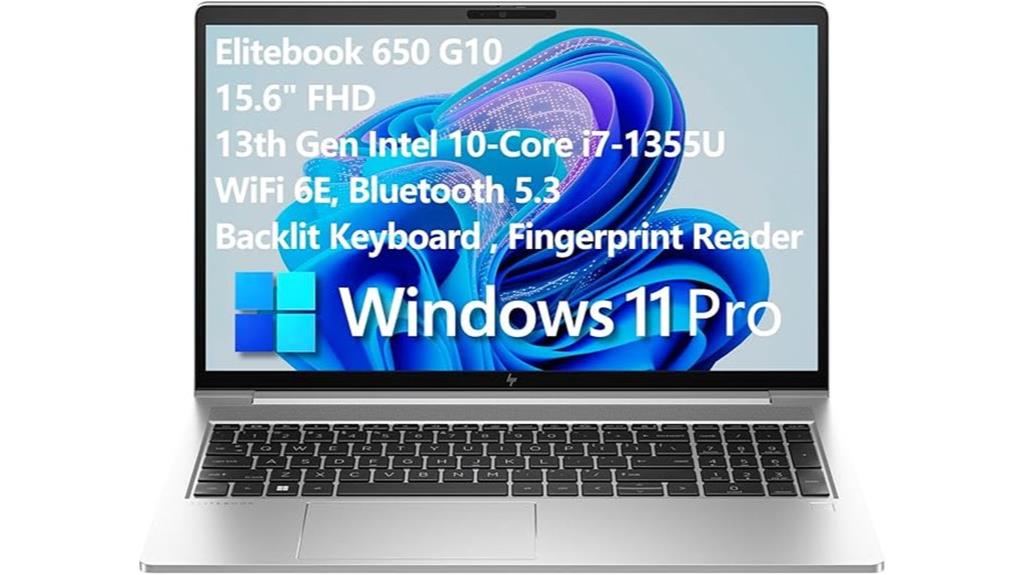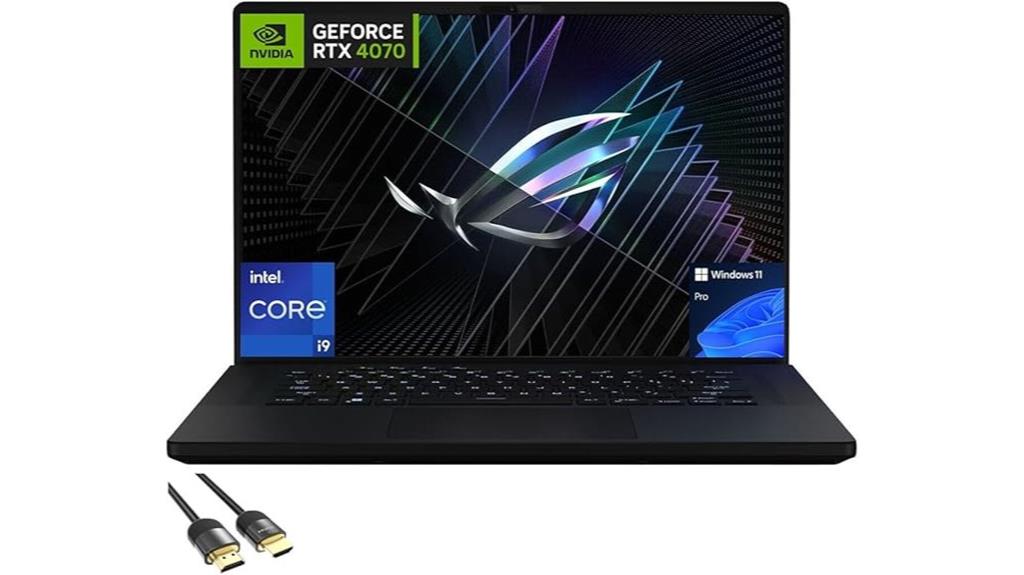



The Lenovo ThinkPad P1 Gen 5 positions itself as a high-performance workstation, combining Intel's vPro i7-12800H processor, NVIDIA A1000 GPU, and 64GB DDR5 RAM to tackle demanding workflows like CAD and 3D rendering. Its 16-inch WQXGA display impresses with sharp visuals and color accuracy, yet thermal management challenges and a bulky 230-watt power supply raise questions about its practicality. While it excels in raw power, its sustained performance and portability remain contentious. For professionals seeking a balance between capability and usability, the ThinkPad P1 Gen 5 presents both compelling strengths and notable trade-offs worth exploring further.
Key Takeaways
- 16-inch WQXGA display with 2560 x 1600 resolution and anti-glare coating for sharp, color-accurate visuals in professional workflows.
- Intel vPro i7-12800H processor and NVIDIA GeForce A1000 GPU deliver high performance for CAD, 3D rendering, and AI applications.
- Thermal management issues cause overheating, with motherboard temperatures reaching 85°C, leading to performance throttling and discomfort.
- 64GB DDR5 RAM and 2TB PCIe SSD ensure smooth multitasking and rapid data access for memory-intensive tasks.
- Battery life degrades rapidly under heavy workloads, dropping from 8 hours to 2 hours, impacting portability and usability.
##
The Lenovo ThinkPad P1 Gen 5, equipped with a 16-inch WQXGA display and powered by an Intel vPro i7-12800H processor, is designed for high-performance business applications. However, its heat management system has raised concerns, with the bezel near the power switch reaching temperatures high enough to cause discomfort or even burns. The motherboard operates at 85°C (185°F), which can lead to performance slowdowns, such as lagging programs and delayed text rendering under heavy workloads. These thermal issues suggest inadequate performance optimization, as excessive heat can throttle the processor and GPU, reducing efficiency. While the device is built for demanding tasks, its thermal design may hinder sustained performance, particularly during prolonged use. Addressing these heat management challenges is critical to ensuring reliable operation and maintaining the laptop's intended productivity capabilities. A potential solution could involve adopting a liquid metal cooling system, similar to the one used in the ASUS ROG Strix G15, to enhance heat dissipation and improve overall thermal performance.
Features and Benefits
The Lenovo ThinkPad P1 Gen 5 features a 16-inch WQXGA high-resolution display, delivering sharp visuals with a 2560 x 1600 pixel resolution. Powered by an Intel vPro i7-12800H processor and NVIDIA GeForce A1000 GPU, it offers robust performance for demanding workloads. With 64GB of DDR5 RAM, the system guarantees efficient multitasking and responsiveness. The laptop also includes advanced security features such as a fingerprint reader and TPM 2.0 for enhanced data protection.
6-Inch WQXGA High-Resolution Display
Featuring a 16-inch WQXGA display with a resolution of 2560 x 1600 pixels, the Lenovo ThinkPad P1 Gen 5 delivers exceptional visual clarity and detail, making it well-suited for professional applications such as graphic design, video editing, and CAD work. The high-resolution screen guarantees sharp display clarity, enabling users to discern fine details in complex designs and high-definition media. Additionally, the display boasts excellent color accuracy, supporting a wide color gamut that meets the demands of color-critical tasks. This makes it ideal for professionals who rely on precise color representation. The anti-glare coating further enhances usability in various lighting conditions, reducing reflections and eye strain. Overall, the WQXGA display is a standout feature, combining resolution, clarity, and color fidelity to meet the needs of demanding workflows.
Intel Vpro I7-12800h Processor
Powered by the Intel vPro i7-12800H processor, the Lenovo ThinkPad P1 Gen 5 delivers robust performance tailored for demanding professional workloads. This 14-core, 20-thread CPU operates at a base clock of 2.4 GHz, boosting up to 4.8 GHz, ensuring seamless multitasking and compute-intensive operations. The processor's thermal performance is optimized for sustained workloads, though high thermal output under heavy usage may require efficient cooling solutions. With Intel's vPro technology, the i7-12800H enhances remote manageability and security, ideal for enterprise environments. Despite its power efficiency improvements over previous generations, the chip's power draw under load can impact battery life. The processor's integration with DDR5 memory further accelerates data throughput, making it a capable choice for professionals in engineering, design, and data analysis.
NVIDIA GeForce A1000 GPU
While designed to handle demanding professional workloads, the NVIDIA GeForce A1000 GPU in the Lenovo ThinkPad P1 Gen 5 delivers workstation-grade graphics performance tailored for CAD, 3D rendering, and AI-driven applications. Built on NVIDIA's Ampere architecture, the A1000 guarantees efficient GPU performance with 2048 CUDA cores and 4GB of GDDR6 memory, enabling smooth handling of complex visual tasks. However, thermal management remains a critical consideration, as the GPU's power-intensive operations can lead to elevated temperatures under sustained loads. The ThinkPad P1 Gen 5's cooling system aims to mitigate heat buildup, though user reports indicate challenges in maintaining peak thermal efficiency during prolonged use. Despite these concerns, the A1000 remains a capable solution for professionals requiring reliable graphics processing in a portable form factor.
4GB DDR5 RAM Capacity
With 64GB of DDR5 RAM, the Lenovo ThinkPad P1 Gen 5 offers substantial memory capacity to support multitasking and memory-intensive applications. The DDR5 technology guarantees superior ram speed optimization, delivering faster data transfer rates and improved efficiency compared to DDR4. This enables seamless handling of complex workflows, such as 3D rendering, large-scale data analysis, and virtualization. The laptop's memory upgrade options provide flexibility for users to expand capacity further, though the 64GB configuration is already well-suited for demanding professional environments. The combination of high-capacity DDR5 RAM and advanced thermal management secures consistent performance, even under heavy workloads. This makes the ThinkPad P1 Gen 5 a robust choice for professionals requiring reliable, high-performance computing solutions.
Product Quality
The Lenovo ThinkPad P1 Gen 5 exhibits significant quality concerns, particularly in thermal management and performance consistency. Heat management is a critical flaw, with the bezel near the power switch reaching temperatures high enough to cause discomfort or burns. The motherboard operates at 85°C (185°F), leading to performance slowdowns, program lag, and text rendering delays under load. Build durability is also compromised, as previous iterations experienced case warping due to excessive heat. These thermal inefficiencies not only degrade user experience but also raise long-term reliability concerns. While the laptop's structural design appears robust, the persistent heat-related issues undermine its overall quality, making it unsuitable for sustained high-performance tasks. These shortcomings highlight a need for improved thermal engineering and material resilience in future models. In contrast, the Dell Latitude 7490 demonstrates superior durability and reliability, meeting stringent standards for prolonged usage.
What It's Used For
The Lenovo ThinkPad P1 Gen 5 is designed for professional content creation, leveraging its high-resolution display and NVIDIA GeForce A1000 GPU for tasks such as video editing, 3D rendering, and graphic design. Its Intel vPro i7-12800H processor and 64GB DDR5 RAM make it suitable for high-performance computing tasks, including data analysis and software development. As a mobile workstation, it supports demanding applications in engineering, architecture, and scientific research, offering portability without compromising on power. The laptop's advanced cooling system ensures efficient heat management, maintaining peak performance during extended workloads.
Professional Content Creation
Designed for demanding workflows, the Lenovo ThinkPad P1 Gen 5 targets professionals in content creation, offering robust hardware tailored for tasks such as 3D rendering, video editing, and graphic design. Its Intel vPro i7-12800H processor and NVIDIA GeForce A1000 GPU guarantee smooth performance for resource-intensive creative workflows. The 16-inch WQXGA display with 2560 x 1600 resolution provides accurate color reproduction, essential for precision in design and editing. However, thermal management remains a concern, as heat buildup can impact sustained performance during prolonged workloads. The 64GB DDR5 RAM and 2TB PCIe SSD storage enable seamless multitasking and rapid data access, critical for handling large project files. Despite its capabilities, users should monitor thermal thresholds to maintain peak performance in high-demand scenarios.
High-Performance Computing Tasks
While engineered to excel in demanding environments, the Lenovo ThinkPad P1 Gen 5 is particularly suited for high-performance computing tasks such as data analysis, scientific simulations, and machine learning workloads. Its Intel vPro i7-12800H processor and NVIDIA GeForce A1000 GPU deliver robust computational power, while 64GB DDR5 RAM guarantees smooth multitasking for memory-intensive applications. However, thermal management remains a critical concern, as the system exhibits performance throttling under sustained loads, with reported temperatures reaching 85°C. This can lead to reduced efficiency during prolonged tasks, impacting productivity. Despite these challenges, the laptop's PCIe SSD storage and Wi-Fi 6 connectivity support rapid data transfer and seamless collaboration, making it a viable option for professionals requiring high-performance computing in a portable form factor.
Mobile Workstation Applications
Although primarily marketed as a business laptop, the Lenovo ThinkPad P1 Gen 5 is engineered to function as a mobile workstation, catering to professionals in fields such as engineering, architecture, and creative design. Its NVIDIA GeForce A1000 GPU and Intel vPro i7-12800H processor enable demanding tasks like 3D rendering, CAD modeling, and video editing. However, thermal management remains a critical concern, as the system operates at high temperatures, potentially impacting sustained performance. Power efficiency is another challenge, with battery life degrading substantially under heavy workloads. Despite these limitations, the laptop's 64GB DDR5 RAM and 2TB PCIe SSD provide ample resources for multitasking and large file handling, making it suitable for on-the-go professionals who prioritize raw performance over portability and thermal comfort.
Product Specifications
The Lenovo ThinkPad P1 Gen 5 is a high-performance business laptop equipped with a 16-inch WQXGA display featuring a resolution of 2560 x 1600 pixels, delivering sharp visuals for professional applications. Powered by an Intel vPro i7-12800H processor and NVIDIA GeForce A1000 GPU, it guarantees robust performance for demanding workloads. The laptop includes 64GB DDR5 RAM and a 2TB PCIe SSD, offering ample storage and fast data access. Despite its powerful internals, thermal management remains a critical consideration, as the system operates at high temperatures under load. Power efficiency is balanced with a 230-watt power supply, though heat dissipation challenges persist. Below is a summary of key specifications:
| Feature | Specification | Details |
|---|---|---|
| Display | 16-inch WQXGA | 2560 x 1600 resolution |
| Processor | Intel vPro i7-12800H | 14-core, 20-thread |
| GPU | NVIDIA GeForce A1000 | 4GB GDDR6 |
| Memory | 64GB DDR5 | 4800MHz |
| Storage | 2TB PCIe SSD | NVMe interface |
The improved cooling system ensures efficient thermal management during intensive tasks, preventing thermal throttling and maintaining optimal performance.
Who Needs This
Designed for professionals requiring uncompromising performance in demanding workflows, the Lenovo ThinkPad P1 Gen 5 caters to users in fields such as engineering, data science, and creative industries. Business professionals will benefit from its Intel vPro i7-12800H processor and 64GB DDR5 RAM, enabling seamless multitasking and resource-intensive applications. Creative professionals, particularly those in 3D rendering, video editing, and graphic design, will appreciate the NVIDIA GeForce A1000 GPU and 2TB PCIe SSD for rapid data processing and storage. The 16-inch WQXGA display guarantees precise color accuracy and clarity, essential for detailed visual work. However, its high-performance components and thermal challenges may limit its appeal to users prioritizing portability or battery life. This laptop is best suited for those who demand workstation-level power in a mobile form factor. The built-in fingerprint reader and TPM 2.0 chip provide enhanced security, ensuring data protection for professionals handling sensitive information.
Pros
Boasting a robust Intel vPro i7-12800H processor and 64GB of DDR5 RAM, the Lenovo ThinkPad P1 Gen 5 delivers exceptional performance for demanding professional workflows, guaranteeing smooth multitasking and efficient handling of resource-intensive applications. Its durable build and lightweight design make it a standout choice for professionals on the go. Key advantages include:
- High-Performance Hardware: The combination of a 12th Gen Intel processor and NVIDIA GeForce A1000 GPU guarantees seamless operation for CAD, 3D rendering, and data analysis tasks.
- Portability: Weighing just 3.99 pounds and measuring 0.7 inches thick, it balances power with portability.
- Premium Display: The 16-inch WQXGA screen offers sharp visuals and accurate color reproduction, ideal for creative and technical work.
- Enhanced Security: Features like the Match-on-Chip fingerprint reader and optional IR camera provide advanced security for sensitive professional environments.
This laptop excels in delivering power and mobility without compromising on durability.
Cons
Despite its impressive hardware specifications, the Lenovo ThinkPad P1 Gen 5 suffers from significant thermal management issues, with the bezel near the power switch and fingerprint reader reaching temperatures high enough to cause discomfort or even burns. The laptop's heat management shortcomings lead to performance issues, particularly under heavy workloads. Key drawbacks include:
- Excessive Heat: The motherboard operates at 85°C (185°F), causing the chassis to warp and creating discomfort during prolonged use.
- Performance Degradation: High temperatures result in noticeable slowdowns, with programs lagging and text rendering slowly.
- Battery Life Decline: Battery performance deteriorates rapidly, dropping from 8 hours to just 2 hours within days of use.
- Inefficient Cooling: Unlike the Acer Nitro V's dual fans, the ThinkPad P1 Gen 5 lacks an effective cooling system, exacerbating heat buildup and performance throttling.
These heat management and performance issues undermine the laptop's potential, making it less reliable for demanding tasks.
What Customers Are Saying
The Lenovo ThinkPad P1 Gen 5 has garnered mixed feedback from users, with a notable focus on its thermal performance and reliability. Customers report significant heat management issues, with the bezel near the power switch reaching temperatures high enough to cause discomfort or burns. The motherboard operates at 85°C (185°F), leading to performance slowdowns and program lag under load. Battery performance has also been a concern, with users noting rapid degradation from an initial 8-hour runtime to just 2 hours within days. The heavy 230-watt power supply and additional docking station requirements further complicate usability. While the device offers robust specifications, these recurring issues have led to dissatisfaction, with some users advising against the P1 series due to persistent reliability challenges. Additionally, the low-Blue Light technology in the display helps reduce eye strain, but this feature does little to mitigate the device's overheating problems.
Overall Value
While the Lenovo ThinkPad P1 Gen 5 offers high-end specifications, including a powerful Intel vPro processor, NVIDIA A1000 GPU, and 64GB DDR5 RAM, its overall value is substantially undermined by persistent thermal and reliability issues. Poor heat management leads to excessive temperatures, with the motherboard reaching 85°C (185°F) and bezel areas becoming uncomfortably hot, impacting both performance and user safety. Additionally, battery longevity degrades rapidly, dropping from an advertised 8 hours to just 2 hours within days of use. These flaws, combined with performance slowdowns under load, diminish the laptop's practicality despite its premium hardware. For professionals seeking a reliable mobile workstation, the ThinkPad P1 Gen 5's compromised thermal performance and inconsistent battery life considerably reduce its value proposition. The WUXGA display found in the ThinkPad E16, with its sharp visuals and vibrant colors, highlights the importance of display quality in professional settings, which the P1 Gen 5 struggles to match due to its thermal limitations.
Tips and Tricks For Best Results
To enhance the performance and longevity of the Lenovo ThinkPad P1 Gen 5, users should prioritize effective thermal management and power enhancement strategies. For heat management, guarantee proper ventilation by using the laptop on hard, flat surfaces and avoiding obstructing air vents. Consider undervolting the CPU and GPU to reduce heat generation without significant performance loss. Utilize Lenovo Vantage software to monitor temperatures and adjust fan profiles for better cooling. For performance enhancement, disable unnecessary background processes and prioritize high-performance power plans during demanding tasks. Regularly update drivers and firmware to guarantee compatibility and efficiency. Additionally, avoid prolonged high-load usage to prevent thermal throttling and maintain consistent performance. These practices will help mitigate heat-related issues and sustain peak functionality.
Conclusion
Although the Lenovo ThinkPad P1 Gen 5 boasts impressive specifications, including a high-performance Intel vPro processor, NVIDIA A1000 GPU, and ample 64GB DDR5 RAM, its execution falls short due to significant thermal and performance issues. Heat management is a critical flaw, with the motherboard reaching 85°C (185°F) and the bezel near the power switch becoming uncomfortably hot. These thermal inefficiencies lead to performance reliability concerns, such as program lag and slow text rendering under load. Additionally, battery life degrades rapidly, and the heavy 230-watt power supply adds inconvenience. While the hardware promises top-tier performance, the system's inability to sustain consistent operation under stress undermines its potential. For professionals seeking reliability, the ThinkPad P1 Gen 5's thermal and performance shortcomings make it a challenging recommendation.



